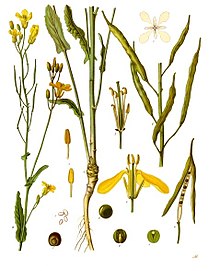Rape oil
| Rapeseed oil seed | |
|---|---|
 |
|
| Rapeseed (Brassica napus) | |
| Scientific classification | |
| Kingdom: | Plantae |
| Clade: | Angiosperms |
| Clade: | Eudicots |
| Clade: | Rosids |
| Order: | Brassicales |
| Family: | Brassicaceae |
| Genus: | Brassica |
| Species: | B. napus |
| Binomial name | |
|
Brassica napus L. |
|
Rapeseed (Brassica napus), also known as rape,oilseed rape (and, in the case of one particular group of cultivars, canola), is a bright-yellow flowering member of the family Brassicaceae (mustard or cabbage family), cultivated mainly for its oil-rich seed. It is the third-largest source of vegetable oil in the world.
The term "rape" derives from the Latin word for turnip, rapum.
Rapeseed is known by many common names in the English language. Some names have only been applied to certain subspecies (subsp.), forms (f.), or varieties (var.) of B. napus. B. napus = B. napus subsp. napus = B. napus subsp. napus f. napus.
This list is from the Germplasm Resources Information Network, which attributes the names to other sources:
Brassica napus grows to 100 cm (39 in) high with lower leaves pinnatifid and glaucous and the upper leaves clasping the stem. The flowers are yellow and about 17 mm (0.67 in) across. B. napus differs from B. nigra, but can be distinguished by the upper leaves which do not clasp the stem, from B. rapa by its smaller petals which are less than 13 mm (0.51 in) across.
In north-east of Ireland B. napus and B. rapa are recorded as escapes in roadside verges and waste ground.
In 1973, Canadian agricultural scientists launched a marketing campaign to promote canola consumption.
Today, rapeseed is grown for the production of animal feed, edible vegetable oils, and biodiesel; leading producers include the European Union, Canada, China, India, and Australia. In India, 6.7 million tons are produced annually. According to the United States Department of Agriculture, rapeseed was the third-leading source of vegetable oil in the world in 2000, after soybean and palm oil. It is the world's second-leading source of protein meal after soybean.
The Food and Agriculture Organization reports 36 million tons of rapeseed were produced in the 2003–2004 season, and estimated 58.4 million tons in the 2010–2011 season. In Europe, rapeseed is primarily cultivated for animal feed, due to its very high lipid and medium protein content.
...
Wikipedia
